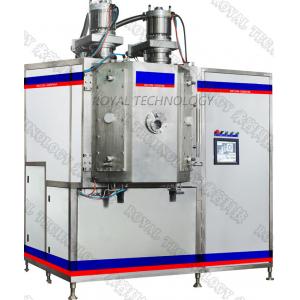

Add to Cart
CrN PVD Plating Machine / PVD CrN Hard Coatings
Hard coatings, formed by reactive Physical Vapor Deposition ( PVD) processes, based on plasma technology,are becoming widely used in the tool industries.
In order to get the most hard, tense, wear-and corrosion-resistant
coating, the substrate temperature should be as high as possible,
and concurrent bombardment by energetic atomic-sized particles (
Ion-plating ) during the reactive deposition should be used. For
example, in coating hardened steel drills, the substrate is heated
to 450℃ or so before deposition is started. This pre-heating can be
done by ion bombardment, which also sputter cleans the surface, or
by using other heating sources in the deposition chamber.
During the process of PVD hard coating for tools, it does not
change the physical dimensions of the part significantly.
The plasma gas used for reactive deposition is a mixture of argon,
nitrogen and ethyne. The composition of the coatings is varied by
varying the gas mixture.
The most common vaporization sources for the ion plating of hard
coatings are unbalanced-magnetron- -sputtering sources, and
cathodic-arc-vaporization sources. Bombardment during deposition is
commonly achieved by applying a negative bias (-200 to -300 volts )
to the substrate and accelerating positive ions to the surface from
a plasma. A high ratio of bombarding ions to depositing atoms is
important for densifying the depositing material. In the
unbalanced-magnetron-sputtering source, few of the sputtered atoms
are ionized; but in the cathodic arc sources, a high percentage of
the vaporized atoms are ionized. Because these “ film ions ” have a
higher mass than do the gas ions, they are better able to sputter
surfaces and densify films by “ atomic peening.”
Industrial tool coatings are typically 1.5 to 4 microns in
thickness.
General Reference: Education Guides to Vacuum Coating Processing,
written by Donald M. Mattox, 2009 by Society of Vacuum Coater.
CrN Hard Coatings Applications:
Hard coatings are becoming widely used in the decorative coating
and industrial tools (HSS or HSC
materials). The coatings are more resistance to wear and corrosion,
to fulfill the tools functions more reliably and for a longer life
time, 2-3 times longer than without coating in general.
Cutting Tools: ( Suggested Coatings: AlTiN/TiAlN, TiCN and TiN)
Sawing, milling, CNC insert ( hard turning using), drilling,
hobbing and gear cutter etc.
Punching & Forming ( Suggested Coatings: CrN, TiCN and TiN)
Metal Stamping
Moulding ( Plastic Injection Mold) -- ( Suggested Coatings: TiCN
and TiN )
Die Casting
Precision Components
Others, like: machine tools, texitile machine, re-coating,
re-sharpening applications etc.
CrN PVD Plating Machine Features:
1. The CrN PVD Plating systems consists of: vacuum chamber, vacuum
pumps, arc sources, spindle & jack, jigs structure, heating
& cooling, water & gas( distribution), electrical control
& operation systems etc.
2. Application: industrial functional coatings for hard tools.
3.Coating Films: TiN, TiC, CrN, AlTiN etc.
4.Coating Advantages: high hardness and wear-resistance and
corrosion,increased tool life time & improved workpiece
quality.
CrN PVD Plating Machine Technical Advantages
1. Strong background of R&D support, focus on details of
manufacturing.
2. Large steered cathodic arc sources to reduce droplets during
depostion.
3. Accurate heating control system, the deviation is ±5℃, when the
substrate surface is up to 550℃.
4. Advanced high density plasma pretreatment.
We are professional in PVD hard coating solutions, please contact us for more specifications, Royal Technology is honored to provide you total coating solutions.
